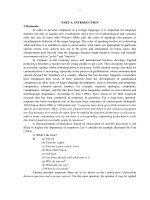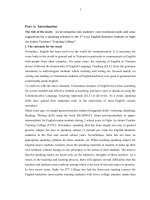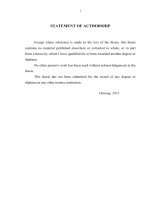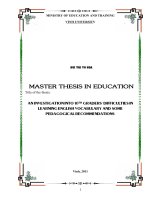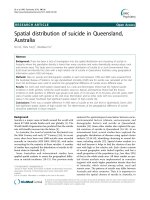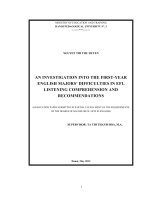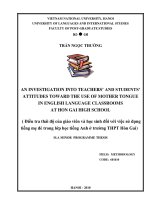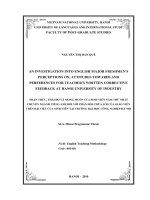AN INVESTIGATION INTO EFL TEACHERS’ PERCEPTIONS AND PRACTICE OF USING TOTAL PHYSICAL RESPONSE (TPR) METHOD TO TEACH ENGLISH TO YOUNG LEARNERS AT SOME PRIMARY SCHOOLS IN QUANG BINH PROVINCE
Bạn đang xem bản rút gọn của tài liệu. Xem và tải ngay bản đầy đủ của tài liệu tại đây (651.69 KB, 86 trang )
MINISTRY OF EDUCATION AND TRAINING
HUE UNIVERSITY
COLLEGE OF FOREIGN LANGUAGES
------------
VO THI THU HUONG
AN INVESTIGATION INTO EFL TEACHERS’
PERCEPTIONS AND PRACTICE
OF USING TOTAL PHYSICAL RESPONSE (TPR) METHOD
TO TEACH ENGLISH TO YOUNG LEARNERS
AT SOME PRIMARY SCHOOLS
IN QUANG BINH PROVINCE
MA THESIS IN THEORY AND METHODOLOGY
OF ENGLISH LANGUAGE TEACHING
HUE, 2014
MINISTRY OF EDUCATION AND TRAINING
HUE UNIVERSITY
COLLEGE OF FOREIGN LANGUAGES
------------
VO THI THU HUONG
AN INVESTIGATION INTO EFL TEACHERS’
PERCEPTIONS AND PRACTICE
OF USING TOTAL PHYSICAL RESPONSE (TPR) METHOD
TO TEACH ENGLISH TO YOUNG LEARNERS
AT SOME PRIMARY SCHOOLS
IN QUANG BINH PROVINCE
MA THESIS IN THEORY AND METHODOLOGY
OF ENGLISH LANGUAGE TEACHING
CODE: 60.14.01.11
SUPERVISOR: Assoc. Prof. Dr. Ed. PHAN VAN HOA
HUE, 2014
BỘ GIÁO DỤC VÀ ĐÀO TẠO
ĐẠI HỌC HUẾ
TRƯỜNG ĐẠI HỌC NGOẠI NGỮ
------------
VÕ THỊ THU HƯỜNG
ĐIỀU TRA VỀ NHẬN THỨC CỦA GIÁO VIÊN
VÀ THỰC TẾ GIẢNG DẠY TIẾNG ANH
SỬ DỤNG PHƯƠNG PHÁP PHẢN ỨNG CƠ HỌC (TPR)
TẠI MỘT SỐ TRƯỜNG TIỂU HỌC Ở QUẢNG BÌNH
LUẬN VĂN THẠC SỸ LÝ LUẬN VÀ PHƯƠNG PHÁP
DẠY HỌC BỘ MÔN TIẾNG ANH
MÃ SỐ: 60.14.01.11
NGƯỜI HƯỚNG DẪN KHOA HỌC:
PGS.TS. PHAN VĂN HÒA
HUẾ, 2014
STATEMENT OF AUTHORSHIP
I hereby acknowledge that this study is mine. The data and findings discussed in
the thesis are true and have not been published elsewhere.
Author
Vo Thi Thu Huong
4
ABSTRACT
This study investigates issues relating to teaching English using Total Physical
Response (TPR) method at some primary schools in Quang Binh. It aims to explore
primary teachers’ perceptions of using TPR to young learners, how teachers use it
in classroom at present, and whether they faced any challenges in teaching process.
The data were collected through the questionnaires, the interviews and the
classroom observations. Twenty primary teachers and fifty pupils in Quang Binh
province participated in the study. The collected data identified the teachers’
perceptions and practice of using TPR to young learners. The findings of the study
revealed that most of the teachers had positive perceptions toward using TPR to
young learners. In spite of the fact that many of the teachers agreed upon the
effectiveness of the TPR method, a few of them still did not feel satisfied because of
some constraints that impeded the successful implementation of TPR. Hence, some
suggestions were forwarded based on the major findings so as to minimize
problems encountered and maximize the implementation of TPR to young learners
at primary schools.
ACKNOWLEDGEMENTS
5
I would never have been able to finish my thesis without the guidance of my
supervisor, committee members; help from friends; and support from my beloved
family.
First of all, I would like to express my deepest gratitude to my thesis supervisor
Mr. Hoa, for his assistance, encouragement, enthusiasm, patience, and immense
knowledge.
My sincere thanks also go to the teachers of the Department of English for the
useful knowledge that they taught me during the time I attended the M.A course.
Additionally, I wish to thank all librarians at Hue College of Foreign Languages
who have created favorable conditions for me to seek and borrow useful documents.
Thirdly, I wish to send my great appreciation to the primary teachers who
participated in this study for their willingness to share valuable ideas and
experiences of teaching English to primary children through the questionnaires and
interviews.
Additionally, I would like to send my sincere thanks to all friends of English
M.A class (2012-2014), especially Hien and Hoa who were always cheering up and
stood by me during the thesis.
My greatest thanks are also sent to my beloved family: parents, elder sister and
two younger brothers. I dedicate this thesis to my family because of their constant
support and their unconditional love. Their love helps me to pursue this degree.
Finally, I offer my regards and blessing to all of those who supported me in the
completion of the thesis.
TABLE OF CONTENTS
Contents
Pages
6
APPENDIX B.............................................................................................................71
APPENDIX C............................................................................................................ 76
APPENDIX D ............................................................................................................77
LIST OF TABLES
7
LIST OF CHARTS
8
LIST OF FIGURES
9
LIST OF ABBREVIATIONS
EFL:
English as a Foreign Language
FLP:
Foreign Language Project
LEA:
Language Experience Activities
L2:
Second Language
TPR:
Total Physical Response
10
CHAPTER I
INTRODUCTION
In this chapter, the background of the study will be presented. Then, the
rationale for the study, the research questions of the study, and the objectives of the
study will be stated. This is followed with the significance and the scope of the
study. Finally, the structure of the study is outlined.
1.1.
Background of the study
English, as global language, plays an important role in the international
interaction (Crystal, 1997). The introduction of English language to young learners
is thus more and more popular in many countries over the world in recent years. In
Vietnam, English language teaching has formally extended to the primary schools
since 2003, as a result of changes in the national English education policy - Foreign
Language Project 2020 of the government (FLP). The major aim of this project is to
motivate the primary school students and help them to be ready and have self confidence in learning English at higher levels.
Nonetheless, teaching English to young learners is quite a hard task for foreign
language teachers unless they are equipped with the appropriate knowledge.
Teaching English to young learners requires a lot of creativity. As Harmer (2001)
stated, young learners especially those up to the ages of primary students, learn
differently from older learners, adolescents and adults. They are easily getting
bored, losing interest after ten minutes or so. If English is taught in an interesting
way, it will motivate students to learn it better. Additionally, children language
ability is developed through practical application. Therefore, the acquisition of
language should be natural and direct. Primary school teachers should realize that
there is no best teaching method, thus they need to apply many different methods to
teach English to young learners. But the applied methods need to be not only
interesting but also effective. Also, Harmer (2007) claimed that some pupils forget
the lesson easily because they are not active during the learning process or not
involved in the learning process directly; there is no good atmosphere of learning
11
process in the class if there is no interaction between teacher and students.
Hence, the teaching methods chosen for young learners should be supported by
suitable techniques and activities which will attract their attention. One of the main
methods is used for teaching language to young learners is Total Physical Response
(TPR) which is just like the way children acquire their native language (Asher,
1977). In fact, the Total Physical Response (TPR) method developed by James
Asher (2000) provides ideas to design the activities for the success of English
language learning and teaching.
1.2.
Rationale for the study
This study is carried out for the following reasons:
Firstly, I graduated from Hue University - College of foreign languages. My
major is teaching English for high school students and I have ever used TPR
method in English classes. However, when I have a chance to teach in a real
environment in primary school, everything becomes different. I myself found that
there is a gap between my perceptions and teaching practice. As a result, my
teaching has not effective yet.
Secondly, although much work has been done to explore issues relating to the
use of TPR method to young learners in recent years (for examples, Widodo, 2005;
Nugrahaningsih, 2007; Wolfe & Jones, 2008; Elliott & Yountchi, 2009; to name
just a few), little attention has been paid to teachers’ perceptions as well as practice
of using TPR, particularly in EFL context.
Finally, the ultimate reason for this study derives from my interest in young
learners, a great concern about TPR method and its importance in teaching and
learning language to young learners. Hence, I hold a firm belief that my study is
well worth.
For those reasons, it is crucial to conduct research on the English language
teachers’ perceptions and practice of using TPR method.
12
1.3. Objectives of the study
The study proposes the objectives as follows:
a. To identify EFL teachers’ perceptions of using Total Physical Response
method to teach young learners in English classes.
b. To describe the implementation of Total Physical Response method to young
learners in English classes as well as find out factors that affect the
implementation of TPR.
c. To provide some suggestions for teaching English to young learners more
effectively.
1.4. Research questions
The study aims to answer the following research questions:
1. What are EFL teachers’ perceptions of using TPR method to teach English to
young learners in English classes?
2. How is TPR method used by the primary teachers in English classes? What
are the factors that affect the implementation of TPR method?
3. What are the suggestions for the teachers to use TPR method to young
learners in English classes effectively?
1.5. Significance of the study
Concerning the objective of this study mentioned above, this study hopefully
can give some contributions as follows:
•
In theory: the result of this research may contribute in modifying theories
that focus on the perceptions and practice of TPR method
• In practice: It may develop language teachers’ perceptions and practice on
the use of TPR and this research is very useful for learning-teaching process
on pupils and teachers of primary schools.
1.6. Scope of the study
The scope of the study was limited within 5 primary schools in Quang Binh
province where an investigation into the use of the TPR method in teaching
English to young learners aged from 8 to 10 is implemented. The main participants
were the teachers of English and pupils at some primary schools in Quang Binh
province.
13
1.7. Structure of the thesis
This thesis is organized into five chapters. The first chapter gives a brief
introduction about the background of the research, research questions, the
objectives, scope as well as structure of the study. In the next chapter, a
fundamental overview of theoretical concepts relating to the research provided. The
third chapter presents methods used to collect data and information of participants.
Questionnaires, interviews and classroom observations are described in more detail.
In the fourth chapter, collected data are calculated and analyzed to draw some
conclusions about perceptions and practice failure to help EFL teachers use TPR
method effectively in their own English classes. Finally, the study summarizes the
research findings, offers implications as well as limitations of the study and makes
suggestions for classroom practice and further research.
14
CHAPTER II
LITERATURE REVIEW
In this chapter, literature related to TPR will be reviewed. In particular, the
chapter discusses perceptions/views about TPR and the way it is implemented as
well as factors that may hinder the implementation of TPR.
2.1. Overview of young learners
2.1.1. Definitions of “young learners"
There are many definitions of young learners, each with slightly different
perspectives. On standard assumptions, “young learners”, known as second
language (L2) learners, refer to children whose first exposure to another language
occurs after their first language has been established for at least three to five years
(Schwartz, 2003; Meisel, 2008). Young learners may start learning English before
they start primary school.
A large number of authors and researchers try to segment learners strictly based
on age: three to five years old, six to eight years old, and so on (Nunan, 2011).
According to Linse (2005), young learners are defined as children between the age
of five and twelve. Meanwhile, Harmer (2001) stated that “young learners,
especially those up to the age of nine or ten, learn differently from older children,
adolescents, and adults” (p.38). In contrary to this view, as Scott and Ytreberg
(1990) defined, young learners are between five and ten or eleven years old. This
point of view is also included in Phillip’s (2003) discussion. In Young Learners,
Phillip identified that young learners are children from the first year of formal
schooling (five or six year old) to eleven or twelve years old. Keep all this in mind,
it needs to be addressed that young learners are unique and different from adult
learners.
Additionally, Scott and Ytreberg (1990) also divide the children into two groups:
the five to seven years old and the eight to ten years old. They assume that the five
to seven years old are all at level one, the beginner stage; the eight to ten years old
are also at the beginning stage but they may have been learning the foreign
language for some times.
15
In a nut shell, “young learners” are children who attend the primary schools
from the first to the fifth grade (six to eleven years old). However, the term “young
learners” in this thesis refers to the children the third and the fifth grade (the age
from eight to ten).
2.1.2. Characteristics of young learners
There have been a number of opinions about this aspect. However, this research
mainly focuses on some important points from different authors in order to present
the young learners’ characteristics.
According to Scott & Ytreberg (1990, p.2-4), the general characteristics of
students in primary schools are:
“They are competence user of mother language; they can tell the difference
between the fact and fiction; they love to play and learn best when they enjoy
themselves, but they also take themselves seriously and like to think what they are
doing is really work; they are enthusiastic and positive about learning; they rely on
the spoken world as well as the physical world to convey and understand meaning;
they are able to work with others and learn from others; their own understanding
comes through eyes, hands and ears; they have very short attention and
concentration span”.
In line with this, Philips (2001) states that “younger learners respond to
language according to what it does or what they can do with it, rather than treating it
as an intellectual game or abstract system […], and are often unselfconscious and
are usually prepared to enjoy the activities the teacher has prepared for them” (p.5).
Under the another viewpoint, Piaget (1970) suggested that teaching English to
children can mean working with very different age groups with different interest and
needs. The range age of the primary schools is from six to eleven years old. Hence,
they have different characteristics and motivations from the students from junior high
school, senior high school or university. That makes teaching primary school students
not the same as teaching adults since the primary school students may have lower
motivation in learning. In this case, in order to successfully teach English to young
learners, language teachers should have specific skills and intuition.
16
Based on “English for Primary Teachers” written by Slattery and Willis (2001),
the characteristics of primary school students are presented as below:
a. Children are learning to read and write in their language.
b. Children are developing as thinkers.
c. Children can plan and organize how best to carry out an activity.
d. Children can work with others and learn from others.
e. Children can understand the difference between real and imaginary.
f.
Children can be reliable and take the responsibility for class activities and
routines.
In learning a foreign language, children and adults have different perceptions
because they have different characteristics. Children are more enthusiastic than
adults. Moreover, they like to please their teacher but they can lose their interest
easily in the materials given (Cameron, 2001; Harmer, 2002).
According to Slattrey and Willis (2001), children between 7 and 12 years are
young learners while those below 7 years old are categorized as very young
learners. Similar to this view, Pinter (2006, p. 2) divides children into younger
learners (before school until grade 2 of elementary school) and older learners (grade
3 until grade 6). The table below explains the differences of them.
Younger learners
Older learners
Children are at pre-school or in the first These children are well established at school
couple of years of schooling
and comfortable with school routine
Generally they have a holistic approach They show a growing interest in
to language, which means that they analytical approaches, which means that
understand meaningful messages but they begin to take an interest in
cannot analyze language yet
language as an abstract system
They have lower levels of awareness They show a growing level
of
about themselves as language learners awareness
as
about
themselves
as well as about process of learning
language learners and their learning
They have limited reading and writing They have well developed skills as
skills even in their first language
readers and writers
They have more concerned about They have a growing awareness of
17
themselves than others and have a others and their viewpoints, and a
limited knowledge about the world
growing awareness about the world
around us
They enjoy fantasy, imagination, and They begin to show interest in real life
movement
issues
(Pinter, 2006, p.2)
From characteristics above, it can be seen that younger learners and older
learners are quite different. As a result, teachers have to know who are going to
interact with.
In theory, there are many descriptions of characteristics of young learners.
Thus, it is indeed to highlight the list of common characteristics which is considered
as the most appropriate characteristics for this study. Basically, young learners refer
to the students of primary school. They like to play and learn through their hands,
eyes, and ears. Young learners will choose the activities they like to do according to
their own characteristics. Concerning those characteristics, using the body
movement in the process of learning is suitable to young learners because “young
children are physically active” (Broughton, 1980, p. 169). They like to do physical
movement. They don’t like to keep staying in one place which forces them not to do
something. Therefore, activities for young learners should include movement.
Teachers will need to have plenty of objects and pictures to work with, and to make
full use of the school and the teachers’ surroundings. Demonstrating what the
teachers want them to do is very important because the perceptive cognition of the
young learners at this age is as far concrete as possible. Furthermore, young learners
can respond without understanding. They tend to learn directly rather than indirectly
through what they see, hear, as well as touch and interaction rather than
explanation. However, young learners also understand what is said before they
understand the individual words. Intonation, gesture, facial expressions, actions, and
circumstances all help to tell them what the unknown words and phrases probably
mean. Also, according to Broughton (1980), young learners “love to imitate and
mime: they are uninhibited in acting out roles, and they enjoy repetition because it
18
gives them a sense of assurance and achievement” (p. 169). It means that they give
attention to other people and try to imitate merely like other people do and say.
This is also the way young learners learn and develop their knowledge.
2.1.3. How young learners learn a language
It is a fact that young learners learn best if they are involved in the process of
teaching and learning. There are some theories regarding the language acquisition
process of young learners. Three theories are mentioned below:
Children construct knowledge through
other people, through interaction with
adults. Adults/teachers work actively
Children learn through social
interaction.
(Vygotsky, 1962)
with children in the Zone of Proximal
Development (ZPD).
Zone of Proximal Development (ZPD) =
difference between the child's capacity
to solve problems on his own and his
capacity to solve them with assistance.
Children construct knowledge from
Children are active learners and
actively interacting with the physical
thinkers.
environment in developmental stages.
(Piaget, 1970)
They
learn
through
their
own
individual actions and exploration.
The adult’s role is very important in a
child’s
learning
process.
Like
Vygotsky, Bruner focused on the
importance of language in a child’s
Children learn effectively through
cognitive development. He shows how
scaffolding by adults. (Bruner, 1983)
the adult uses “scaffolding” to guide a
child’s
language
learning
through
finely-tuned talk. (Cameron, 2001)
(Woro Retnoningsih, 2012, p.3-4)
The distinction between Vygotsky’s and Piaget’s views was that while
Vygotsky (1962) believed that language was central to the cognitive development
19
of children (that it was instruction provided by an adult that helped children learn
and develop), Piaget (1970) claimed that children work through different
developmental stages of learning on their own. The development of children, which
is suggested by Piaget (1970), includes four specific stages as follows:
a. Sensori-Motor Stage (from 0 – 2 years) in which children seemed to learn
through physical interaction with the world around them.
b. Pre-Operational Stage (from 2 - 7 years) when children need concrete situations
to process ideas.
c. Concrete Operational Stage (from 7 - 11 years) in which children begin to
conceptualize and do some abstract problem solving, though they still learn
best by doing.
d. Formal Operational Stage (from 1-15) in which children are able to use
abstract thinking.
Furthermore, the support given by adults was described as scaffolding by
Bruner (1983). With scaffolding children develop and grow because the adults give
support to their thinking and learning process. The term scaffolding is widely used
in English language teaching when teachers provide support in the learning process
to facilitate the learning either by providing the vocabulary or asking some guiding
questions.
Aside from the theories presented above, there are also some theories regarding
the language acquisition process. The critical period hypothesis introduced by
Lenneberg (1967) puts forward the idea that young children can learn a foreign
language effectively before puberty as brain reaches its adult values until puberty
and there will be a loss of brain plasticity and its reorganizational capacities
(Canbulat & ÇayirogluIsgören, 2005; Gürsoy, 2011; Pinter, 2006). However,
Donaldson (1978, cited in Hughes, 2009) believed that children were able to
cognitively develop by trying to make sense of the experiences that they had, and by
asking questions and trying things out, or hypothesizing.
To be more obvious, Moon (2000) also points out that young learners learn a
foreign language “through being motivated; by listening and repeating; by
20
imitating the teacher; by doing and interacting with each other in an atmosphere of
trust and acceptance; through a variety of interesting and fun activities for which
they see the purpose; through translating sentences into their own language “(p.3).
Related to the different ways that children learn about their world, some authors
(Berman, 1998; Brewster, 2002; Smeets, 2004) referred to children’s preferred
learning styles. They may be characterized as visual, auditory or kinesthetic
learners. A visual learner learns best if they see what is happening and links to their
understanding. On the other hand, an auditory learner will need to hear the input,
while a kinesthetic learner will learn best if the learning involves physical
movement.
Considering children’s preferred learning styles are important since some
research (Berman, 1998 in Ellis & Brewster, 2002) showed that there was a
correlation between success in language learning and preferred learning styles. This
is also supported by a research conducted by Rosemary Smeets (2004) who looked
at young language learners and learning styles and she found that the students did
seem to be able to learn more words when using their preferred learning style
(visual, auditory or kinesthetic).
Among those theories, I strongly agree with Piaget (1970) when he suggested
that young learners aged 7-11 years old or within concrete operational stage learn
best from concrete things around them. Also, I admitted that language was central
to the cognitive development of children, that it was instruction provided by an
adult that helped children learn and develop (Vygotsky, 1962). In particular,
children aged 8-10 are competent mother tongue users (Scott & Lisbeth, 1992). In
addition, Scott & Lisbeth also say that children particularly aged 8-10 are mature
enough. Therefore, at these ages, children can grasp abstract and symbols generalize
language and systematize it.
It is clear that activities for young learners should include movements and
involve the sense. From the points of explanation above, children like to be
involved in something active. It is a supporting point for teaching children using the
Total Physical Response, since the TPR is full with real situation being
21
demonstrated.
To make them active, it is necessary that teachers use the activities involved in
something new (visuals, meaningful contexts, various activities, games, songs, and
technology). This would make learning more enjoyable and faster because they all
appeal to young learners. Besides, the language teachers should be able to make the
circumstance of learning process which is suitable to the characteristics of the
students. It may give motivation to the students to learn effectively.
To sum up, based on those above – mentioned characteristics and the way
young learners acquire a language, I considered children from eight to ten years old
( from grade 3 to 5) as the target of my study. My choice derived from a firm belief
that children’s cognition at those ages is developmental enough to participate in the
study’s survey.
2.2. Teaching English to young learners in the elementary school
2.2.1. Teaching English to young learners: advantages and disadvantages
Based on young learners’ development and characteristics, it is indeed to explain
why teaching English to young learners is important. Pinter (2006) points out the
reason why English should be taught to young learners in primary schools. It is
related to term “sensitive period” which psycholinguistics explained for teaching
language to children. This term comes from Lenneberg (in Pinter, 2006) who
proposed Critical Period Hypothesis (CPH). He states that brain plasticity was only
conducive to language learning until puberty. Therefore, children who start earlier
than eleven to twelve years of age, given advantageous learning circumstances,
such as plenty of input and interaction in an English environment, are more likely to
acquire English to native levels without an accent.
Scovel (in Brewster & Ellis, 2004) supports Lenneberg’s idea and points out that
language is best learned during the early years of childhood. In addition, an official
reference bulletin for educators published by the French Ministry of Education,
Bulletin Officiel de I’Education Nationale, (in Brewster & Ellis, 2004) argues that
the aim of early foreign language learning was not the creation of bilingual children
but more reasonably, to prepare children linguistically, psychologically, and
22
culturally for language learning.
Moreover, starting foreign language lesson at young age would have
physiological advantages. Young learners tend to pick up a language easily,
especially as far as oral ability is concerned. Research has shown that
individuals learning a language at a young age can achieve near native
pronunciation (Huda, 1999).
Therefore, learning language in early years is important for children. They can
comprehend their native language and other languages in the early years, and they
even can acquire English to native levels without an accent before the age of eleven
to twelve because of their brain plasticity.
There are some misunderstandings that many teachers still hold (Cameron,
2001), as follows:
a. Teaching children is easy and simple
Teaching English to young learners is not an easy thing. The first reason is
children’s world is different from adults’. They do not have the same access to
comprehend the grammar (Cameron, 2001). The second reason is children can lose
their interest quickly. They may show their interest at the beginning of the learning
but in the middle of it, if the teacher gives them the same thing, they will feel bored.
Therefore, teachers as the instructors and the class managers should know their
students and the class well.
b. Children just need to learn simple language
Children are like a piece of blank paper. People around them can write anything
on it. If they are just taught with simple thing they will just have that in their mind.
In fact, they may be interested in more complicated thing, such as how to operate a
computer, what are dinosaur look like, etc. Teachers should realize those things.
2.2.2. Teachers of young learners
In teaching as well as learning process, language teacher plays an important role
in transferring knowledge and skill to the students; to guide them in developing
23
their mind; to educate them on how to absorb; to analyze; and to expand their
individual knowledge and skill.
Concerning the elementary school English teachers’ characteristics, Slattrey
(2002) addressed that teachers should encourage students to read in English (stories,
comics, reading games) and encourage them to work meaning out for themselves. In
addition, it is necessary to explain thing about language as well as use a wider range
of language input as their model for language use. He also stated that teachers need
to encourage creative writing and help them to experiment with the language.
From statements above, I completely agree with them. Thus, it is crucial for the
primary school English teacher to be more creative in teaching, for example by
using some interesting media and method. By these ways, the students could enjoy
the lesson more.
However, to the extent of teaching English to young learners, Musthafa (2010)
delineated requirements that should be fulfilled by teachers of young learners, they
are as follows:
a. Teachers of young learners should know who the children are.
It is important for teachers to know who young learners are before they want to
get involved in the teaching and teachers of young learners should know how
children learn. In order to support this point of view, Stros (1995) pointed out that
children learn by doing and they need to make sense of the world – they can “grasp”
meaning even if they do not fully understand language. Moreover, the process of
learning is as important as the product and success breeds success.
b. Teachers of young learners should know how children learn foreign
language.
In the context of teaching, most people assume that children learn a foreign
language in the same way that they learn their mother tongue. Basically, children
are potential in acquiring and learning a foreign language, and they even learn it
more quickly than those who are learning the foreign language after puberty
(McLaughlin, 1978). On the contrary, children are less capable of absorbing or
acquiring a foreign language optimally (Long, 1990).
24
Followings are some ways teachers can apply in facilitating children learning
English as a foreign language:
a. Giving exposure by using English for the instruction
In giving the instruction, it is strongly recommended that the teacher used
English from the beginning until the end. It is good to provide the target language
input and to encourage them to speak English in the teaching and learning process.
In accordance with Pinter (2006) who claims that teachers who often talk a lot in
the target language, even in the beginning stages of learning a language, can
provide the language input for their students. This helps them to get used to the
patterns of intonation and the sounds of the language. This exposure can be a model
for the students to communicate in English.
b. Giving children chances to be engaged in the teaching and learning process
After the teacher gives the model, the children engage in the learning process by
practicing. Teacher also gives them some chances to practice whether it is in pairs
or in groups.
c. Giving supports to children
Supporting children by giving appreciation after they perform is important.
Support in form of credit or reward can help children in gaining their selfconfidence. If in the performance time they made some mistakes, however, teacher
should give the reward first and then after that correcting the mistakes.
d.
Providing good techniques of teaching
Teacher should provide good instruction in teaching children. However, in the
real life, the instructions that are used to teach the elementary school students
emphasize more on mastering grammatical structure, so that the students fell
burdened than joy in learning English (Andini: 2007). Moreover, the students are
often asked to memorize the material than to give their own opinions (Utami, 2004).
To this regard, teacher should be creative and find appropriate instructions or
techniques, which are child-friendly, so that the objectives of the teaching and
learning process can be achieved. In addition, the teacher should use a variety of
instructions since children have a limited attention span, so they can easily get
25
